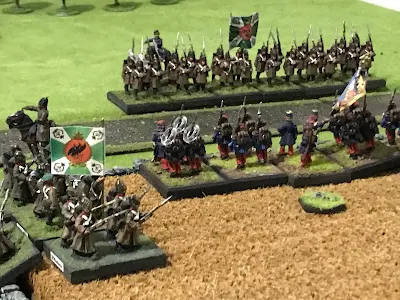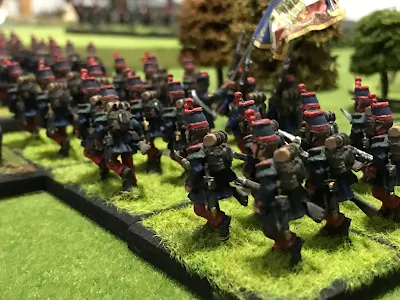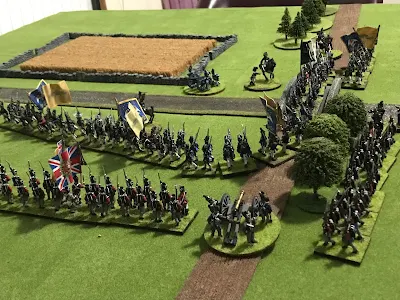Set in 1854 outside the Savastapol siege lines French and Russian forces are attempting to capture a major bridge crossing. Because of its importance the bridge cannot be destroyed but must be captured intact. Both sides have similar sized forces which reflects the armies of their time period. Victory conditions are to capture and hold both sides of the bridge by game end. If either force is reduced to under 50% that side must retreat off the board and has lost. In addition both sides may select one unit to out flank the enemy and appear on a random turn on the enemies flank across the river. I rolled to see which side of the table to set up on. I also came up with two battle plans for each side for what they wanted to do. Rules used are "Charge of the Light Brigade" by David Raybin.
Order of Battle:
Russian Army:
16th Division (Lt. Gen. Kvetinski)
1st brigade:
Vladimirski Regt. (4 bns) (24 ea.)
Susdalski Regt. (2 bns) (24 ea.)
16th Artillery Battery
Uhlan regiment (12)
French Army
1st Brigade (Espinasse) Reinforced
3rd Zouaves (2 battalions)
7th Ligne. (2 battalions)
20th de Ligne (2 battalions)
1st Chasseurs d'Afrique
Artillery Battery
The Russian army set up within the river bend. The four battalions of the Vladimirski Regiment were sent in column up the road to cross the bridge. The two battalions of the Susdalski Regiment were to their left to guard against a flank attack and then support the bridge crossing. The artillery quickly took up position and the Cavalry were sent to flank the enemy.
The French sent their artillery to the high ground with a good field of fire. The 3rd Zouaves Regiment guarded the center while the 7th Ligne took the left flank. The 20th de Ligne prepared to defend the right flank and the 1st Chasseurs d'Afrique were sent to out flank the Russians.
The French quickly moved up to the front. The 3rd Zouaves deployed into line by the bridge to maximize their firepower. The 20th moved up to support them while the 7th moved to deploy along the river bend. Taking their time the gunners opened fire on a target rich environment.
The Russian forces bullied their way across the bridge. The 1/ Vladimirski crossed quickly and charged the French in front while 2/ & 3/Vladimirski moved across and took position. (In these rules battalions can do additional things by paying a command point (CO). Slower moving troops (like Russians) have fewer CP's while better troops and quicker have more. Once your CP's are gone they are gone. You pay for thus by the other side can pivot/change formation or fire at you!)
The 2/3rd Zouaves easily defeated the 1/Vladimirski and sent them flying. But this gave time for 2/ & 3rd battalions to cross over. One battalion slammed into the 2/20th de Ligne and routed them. They 2/3rd Zouaves were not as lucky and they were broken by a fresh column of the 3/Vladimirski.
At the point (turn 4) the French Center was broken but the Russian infantry was in bad shape. Two battalions were reforming and could not help the ones across the river. Another battalion was slowly being shot apart by the French battery and the 1/7th Ligne . But the French had two battalions ((1/3rd Zouaves and 2/20th) of their own reforming! A close run fight so far.
On the 5th turn the Russian cavalry made it's appearance! They charged the 1/7th Line. ( I did a morale check for the French, they passed so I let them change facing). They managed to get a very good volley in which sent the Cavalry back the way they came. On the opposite flank the 1/Susdalski crossed the bridge to add their numbers to the attack. The Russian commanders rallied the broken battalion and hustled them back across the Bridge. But the French were holding fast and they also had battalions returning.
The decisive moment came in the 7th turn. Both sided were weakened and slowing down. But the 1st Chasseurs d'Afrique made their appearance on the Russian flank. They charged forward against the 2/Susdalski who tried to turn to face the cavalry but failed (in the morale roll the two morale markers made the difference. For each marker you have on a battalion you subtract 1 from each roll). In the melee the Chasseurs rode down the infantry from the flank and routed them and pursed the fleeing soldiers.
In the center the fresh French battalions were too much for the weakened Russian infantry. Attacked in all sides first one battalion then another broke. Too much had been asked of the Russians who fought valiantly. There were no more reinforcements to be called up. General Kvetinski threw in the towel and ended the slaughter.
Another very hard fought battle that went to the final turn. The Russian battalions in column get a +2 per die in melee which makes them very dangerous. But the French have much better firepower and with more CP's can do more extra per turn. Because of the shorter range of the Russians muskets they could not stand off and trade shots. The French with rifled muskets could and we're glad to do so all day. So the only way the Russians could force the issue was closing to melee. The French cavalry charge at the end did not decide the battle but it did take out the final fresh infantry the Russians had.
And this concludes our third and final game. A great successful series and a very good scenario. Looking over the suggestions from Norm a hidden ford or two might be intetesting. At least the bridge would not be the center of all fights. When I try this again I will add that. Also, I have added the house rule for the unit out flanking the enemy. In the first game cavalry ran right into infantry. Now, I test the defenders morale and if they pass they can turn to face the attackers. I think this balances it out nicely.





































































